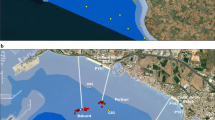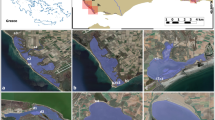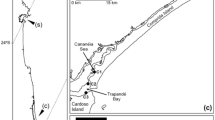Abstract
Studies related to heavy metal concentrations in coastal sediments are important to monitor and assess environmental health of estuarine ecosystems. Twenty-eight samples from Parnaíba River Delta, the largest open-ocean delta in the Americas, northeastern of Brazil were tested for heavy metals concentrations (Cd, Cr, Cu, Mn, Ni, Pb, Zn, Al and Fe), grain-size and easily oxidizable carbon. The relations of the heavy metals with sediment composition were evaluated using a multivariate statistical analysis. Sediment pollution assessment was carried out by enrichment factor (EF), geoaccumulation index (Igeo), contamination factor (CF) and potential ecological risk index (PERI). The average concentrations were 0.50 ± 0.09 mg Cd kg−1, 6.95 ± 2.13 mg Pb kg−1, 19.02 ± 8.75 mg Cu kg−1, 23.20 ± 5.04 mg Ni kg−1, 33.52 ± 6.82 mg Cr kg−1, 43.99 ± 7.47 mg Zn kg−1, 165.73 ± 86.71 mg Mn kg−1, 2.93 ± 0.89% to Fe and 3.78 ± 1.17% to Al. The results indicate lower concentrations of heavy metals relative to limit concentrations defined by the Brazilian regulatory framework. The multivariate analysis reflected the binding of heavy metals to clay minerals and organic carbon. The different geochemical indices indicated sediments minimally enriched by metals and a low potential ecological risk level. Our assessment confirms the pristine conditions of Parnaíba Delta protected area to heavy metal contamination, except Igaraçú channel near Parnaíba city.







Similar content being viewed by others
References
Aguiar JE, Marins RV, Almeida MD (2007) Comparison of marine sediment digestion methodologies for the characterization of trace-metal geochemistry on the northeast Brazilian continental shelf. Geochim Bras 21(3):304–323
Aguiar JE, Lacerda LD, Miguens FC, Marins RV (2014) The geostatistics of the metal concentrations in sediments from the eastern Brazilian continental shelf in areas of gas and oil production. J S Am Earth Sci 51:91–104. https://doi.org/10.1016/j.jsames.2013.12.005
Beraldi GQF, Rezende CE, Almeida MG, Carla C, Lacerda LD, Farias RN, Vidal M, Souza MDP, Molisani MM (2019) Assessment of a coastal lagoon metal distribution through natural and anthropogenic processes (SE, Brazil). Mar Pollut Bull 146:552–561. https://doi.org/10.1016/j.marpolbul.2019.07.007
BRASIL (2012) Brazilian National Council of the Environment—CONAMA. Resolution no. 454. Publication DOU, of 11/08/2012, Section 1, p. 66. http://www2.mma.gov.br/port/conama/legiabre.cfm?codlegi=693. Accessed 20 Dec 2019
Buzzi NS, Marcovecchio JE (2018) Heavy metal concentrations in sediments and in mussels from Argentinean coastal environments. S Am Environ Earth Sci 77:321. https://doi.org/10.1007/s12665-018-7496-1
Carvalho CEV, Salomão MSMB, Molisani MM, Rezende CE, Lacerda LD (2002) Contribution of a medium-size tropical river to the particulate heavy-metal load for the South Atlantic Ocean. Sci Total Environ 284:85–93. https://doi.org/10.1016/S0048-9697(01)00869-5
CCME—Canadian Council of Ministers of the Environment (2001) Canadian Sediment Quality Guidelines for the Protection of Aquatic Life: Introduction, updated in Canadian Environmental Quality Guidelines. 1999. Winnipeg, Manitoba. https://www.pla.co.uk/Environment/Canadian-Sediment-Quality-Guidelines-for-the-Protection-of-Aquatic-Life. Accessed 20 Dec 2019
Chakraborty S, Chakraborty P, Sarkar A, Kazip A, Mascarenhas-Pereira MBL, Nagender Nath B (2019) Distribution and geochemical fractionation of lead in the continental shelf sediments around India. Geol J 54:1190–1204. https://doi.org/10.1002/gj.3218
Chen Y, Jiang X, Wang Y, Zhuang D (2018) Spatial characteristics of heavy metal pollution and the potential ecological risk of a typical mining area: a case study in China. Process Saf Environ 113:204–219. https://doi.org/10.1016/j.psep.2017.10.008
De Paula Filho FJ, Marins RV, Aguiar JE, Peres TF, Lacerda LD (2014) Emisiones naturales y antrópicas de Zn, Cu, Pb, Cr, Cd y Hg al Delta del Río Parnaíba/NE/Brasil. In: Marcovecchio, Botté, Freije (eds) Procesos Geoquímicos de la Superficie en América Latina. Sociedad Iberoamericana de Física y Química Ambiental, Sección 2 – Capítulo 13. Salamanca, España, pp 179–202. https://www.sifyqa.org.es/libro_pqsi.pdf. Accessed 10 Dec 2019
De Paula Filho FJ, Marins RV, Lacerda LD, Aguiar JE, Peres TF (2015a) Background values for evaluation of heavy metal contamination in sediments in the Parnaíba River Delta estuary. NE/Brazil Mar Pollut Bull 91(2):424–428. https://doi.org/10.1016/j.marpolbul.2014.08.022
De Paula Filho FJ, Marins RV, Lacerda LD (2015b) Natural and anthropogenic emissions of N and P to the Parnaíba River Delta in NE Brazil. Estuar Coast Shelf Sci. 166:34–44. https://doi.org/10.1016/j.ecss.2015.03.020
Federal Decision 28th August (1996) Brazilian Federal Government. http://www.planalto.gov.br/ccivil_03/DNN/Anterior%20a%202000/1996/Dnn4368.htm Accessed 01 Nov 2020
Devanesan E, Suresh Gandhi M, Selvapandiyan M, Senthilkumar G, Ravisankar R (2017) Heavy metal and potential ecological risk assessment in sedimentscollected from Poombuhar to Karaikal Coast of Tamilnadu using Energy dispersive X-ray fluorescence (EDXRF) technique. Beni-Suef Univ J Basic Appl Sci 6:285–292. https://doi.org/10.1016/j.bjbas.2017.04.011
Dias FJS, Castro BM, Lacerda LD, Miranda LB, Marins RV (2016) Physical characteristics and discharges of suspended particulate matter at the continent-ocean interface in an estuary located in a semiarid region in northeastern Brazil. Estuar Coast Shelf Sci 180:258–274. https://doi.org/10.1016/j.ecss.2016.08.006
El-Kady AA, Wade TL, Sweet ST, Klein AG (2019) Spatial distribution and ecological risk assessment of trace metals in surface sediments of Lake Qaroun. Egypt Environ Monit Assess 191:413. https://doi.org/10.1007/s10661-019-7548-3
Fadigas FS, Sobrinho NMBA, Mazur N, Anjos LHC, Freixo AA (2006) Proposition of reference values for natural concentration of heavy metals in Brazilian soils. Rev Bras Eng Agric Ambient 10(3):699–705. https://doi.org/10.1590/S1415-43662006000300024
Farias ACS, Filho AAF, Ivo CTC, Fernande CAF, Cunha FEA (2015) Productive chain of fishing in the interior of the Parnaíba Delta and adjacent marine area. RDS, Fortaleza, p 240
Gholizadeh M, Patimar R (2018) Ecological risk assessment of heavy metals in surface sediments from the Gorgan Bay. Caspian Sea Mar Pollut Bull 137:662–667. https://doi.org/10.1016/j.marpolbul.2018.11.009
Hakanson L (1980) An ecological risk index for aquatic pollution control: a sedimentological approach. Water Res 14(8):975–1001. https://doi.org/10.1016/0043-1354(80)90143-8
He D, Shi X, Wu D (2016) Particle-size distribution characteristics and pollution of heavy metals in the surface sediments of Kuitun River in Xinjiang. China Environ Earth Sci 75:104. https://doi.org/10.1007/s12665-015-4882-9
Ismail A, Toriman ME, Juahir H, Zain SM, Habir NL, Retnam A, Kamaruddin MK, Umar R, Azid A (2016) Spatial assessment and source identification of heavy metals pollution in surface water using several chemometric techniques. Mar Pollut Bull 106(1–2):292–300. https://doi.org/10.1016/j.marpolbul.2015.10.019
Jara-Marini ME, Soto-Jimenez MF, Paez-Osuna F (2009) Trophic relationships and transference of cadmium, copper, lead and zinc in a subtropical coastal lagoon food web from SE gulf of California. Chemosphere 77:1366–1373. https://doi.org/10.1016/j.chemosphere.2009.09.025
Karim Z, Qureshi BA, Mumtaz M, Qureshi S (2014) Heavy metal content in urban soils as an indicator of anthropogenic and natural influences on landscape of Karachi—a multivariate spatiotemporal analysis. Ecol Indic 42:20–23. https://doi.org/10.1016/j.ecolind.2013.07.020
Krumbein WC (1934) Size Frequency distribution of sediments. J Sediment Petrol 4(2):65–77. https://doi.org/10.1306/D4268EB9-2B26-11D7-8648000102C1865D
Lacerda LD, Molisani MM, Sena D, Maia LP (2008) Estimating the importance of natural and anthropogenic sources on N and P emission to estuaries along the Ceará State Coast NE Brazil. Environ Monit Assess 141:149–164. https://doi.org/10.1007/s10661-007-9884-y
Lacerda LD, Marins RV, Dias FJS (2020) An Arctic Paradox: response of Fluvial Hg inputs and bioavailability to global climate change in an extreme coastal environment. Environ Front Earth Sci 8:93. https://doi.org/10.3389/feart.2020.00093
Li Z, Deblon J, Zu Y, Colinet G, Li B, He Y (2019) Geochemical baseline values determination and evaluation of heavy metal contamination in soils of Lanping Mining Valley (Yunnan Province, China). Int J Environ Res Public Health 16(23):4686. https://doi.org/10.3390/ijerph16234686
Liu S, Shi X, Liu Y, Zhu Z, Yang G, Zhu A, Gao J (2011) Concentration distribution and assessment of heavy metals in sediments of mud area from inner continental shelf of the East China Sea. Environ Earth Sci 64:567–579. https://doi.org/10.1007/s12665-011-0941-z
Liu X, Huang D, Zhu Y, Chang T, Liu Q, Huang L, Zhao W, Lin K, Liu L (2015) Bioassessment of marine sediment quality using meiofaunal assemblages in a semi-enclosed bay. Mar Pollut Bull 100:92–101. https://doi.org/10.1016/j.marpolbul.2015.09.024
Long ER, Morgan LG (1990) The potential for biological effects of sediments-sorbed contaminants tested in the National Status and Trends Program. Seattle: NOAA Tech Memo NOS OMA 52. U.S. National Oceanic and Atmospheric Administration. 175 pp + appendices. http://udspace.udel.edu/handle/19716/1562. Accessed 20 December 2019
Loring DH, Rantala RTT (1992) Manual for the geochemical analyses of marine sediments and suspended particulate matter. Earth Sci Rev 32(4):235–283. https://doi.org/10.1016/0012-8252(92)90001-A
Marcovecchio J, Ferrer L (2005) Distribution and geochemical partitioning of heavy metals in sediments of the Bahía Blanca estuary. Argentina J Coast Res 21(4):826–834. https://doi.org/10.2112/014-NIS.1
Marins RV, Paula Filho FJ, Maia SRR, Lacerda LD, Marques WS (2004) Total mercury distribution as a proxy of urban and industrial pollution along the Brazilian coast. Quim Nova 27:763–770. https://doi.org/10.1590/S0100-40422004000500016
McCave I, Syvitski J (1991) Principles and methods of geological particle size analysis. In: Syvitski JPM (ed) Principles, methods and application of particle size analysis. Cambridge University Press, Cambridge, pp 1–21. https://doi.org/10.1017/CBO9780511626142
Mellis EV, Cruz MCP, Casagrande JC (2004) Nickel adsorption by soils in relation to pH, organic matter, and iron oxides. Sci Agric 61(2):190–195. https://doi.org/10.1590/S0103-90162004000200011
Mendonza-Carranza M, Sepúlveda-Lozada A, Dias-Ferreira C, Geissen V (2016) Distribution and bioconcentration of heavy metals in a tropical aquatic food web: a case study of a tropical estuarine lagoon in SE Mexico. Environ Pollut 210:155–165. https://doi.org/10.1016/j.envpol.2015.12.014
Schettini CAF, Miranda JB, Valle-Levinson A, Truccolo EC, Domingues EC (2016) The circulation of the lower Capibaribe Estuary (Brazil) and its implications for the transport of scalars. Braz J Oceanogr 64(3):263–276. https://doi.org/10.1590/S1679-87592016119106403
MMA (2006) Ministério do Meio Ambiente. Secretaria de Recursos Hídricos. Caderno da Região Hidrográfica do Parnaíba. Brasília: 2005. http://pnrh.cnrh-srh.gov.br. Accessed 13 Dec 2019
Moreira LB, Saes RVST, Peres TF, Taniguchi S, Bicego MC, Marins RV, Abessa DMS (2019) Toxicity of sediments and dredged material from a semi-arid coastal system to marine invertebrates. Ecotox Environ Safe 14(1):79–89. https://doi.org/10.5132/eec.2019.01.10
Moreira LB, Sasaki ST, Taniguchi S, Peres TF, Figueira RCL, Bícego MC, Marins RV, Costa-Lotufo LV, Abessa DMS (2020) Biomarkers responses of the clam Anomalocardia flexuosa in sediment toxicity bioassays using dredged materials from a semi-arid coastal system. Heliyon 6(5):e04030. https://doi.org/10.1016/j.heliyon.2020.e04030
Müller G (1969) Index of geo-accumulation in sediments of the Rhine River. Geo J 2:108–118
Nascimento FS, Freire GSS, Miola B (2010) Geochemistry of marine sediments of the Brazilian Northeastern continental shelf. Braz J Oceanogr 58(spe2):01–11. https://doi.org/10.1590/S1679-87592010000600002
Nelson DW, Sommers LE (1982) Total carbon, organic carbon, and organic matter. In: Page AL, Miller RM, Keeney DR (eds) Methods of soil analysis: part 2 ed., Chemical and microbiological properties, second ed. Agronomy Series 9. American Society of Agronomy, Madison, pp 539–579
Neşer G, Kontas A, Ünsalan D, Uluturhan E, Altay O, Darılmaz E, Küçüksezgin F, Tekoğul N, Yercan F (2012) Heavy metals contamination levels at the Coast of Aliağa (Turkey) ship recycling zone. Mar Pollut Bull 64:882–887. https://doi.org/10.1016/j.marpolbul.2012.02.006
North MA (2009) A method for implementing a statistically significant number of data classes in the Jenks algorithm. In: Fuzzy Systems and Knowledge Discovery, 2009. FSKD'09. Sixth International Conference on, IEEE, pp. 35–38. https://doi.org/10.1016/10.1109/FSKD.2009.319
Oliveira RCB, Marins RV (2011) Trace metals dynamics in soil and estuarine sediment as a major factor controlling contaminants contribution to the aquatic environment: review. Rev Virtual Quim 3(2):88–102. https://doi.org/10.5935/1984-6835.20110014
Paula FCF, Lacerda LD, Marins RV, Aguiar JE, Ovalle ARC, Falcao Filho CAT (2010) Natural and anthropogenic emissions of metals and nutrients to the lower contas river basin, Bahia state. Brazil. Quím Nova. 33(1):70e75. https://doi.org/10.1590/S0100-40422010000100014
Pereira MD, Siegle E, Miranda LD, Schettini CAF (2010) Seasonal hydrodynamic and suspended particulate matter transport in a tidally dominated estuary: Caravelas Estuary, Bahia. Brazil Rev Bras Geof 28(3):427–444. https://doi.org/10.1590/S0102-261X2010000300008
Rios JHL, Marins RV, Oliveira KF, Lacerda LD (2016) Long-Term (2002–2015) Changes in Mercury Contamination in NE Brazil Depicted by the Mangrove Oyster Crassostraea rhizophorae (Guilding, 1828). Bull Environ Contam Toxicol 97:474–479. https://doi.org/10.1007/s00128-016-1855-y
Sabadini-Santos E, Knoppers BA, Oliveira EP, Leipe T, Santelli RE (2009) Regional geochemical baselines for sedimentary metals of the tropical São Francisco estuary. NE-Brazil Mar Pollut Bull 58:601–634. https://doi.org/10.1016/j.marpolbul.2009.01.011
Santos HG, Jacomine PKT, Anjos LHC, Oliveira, VA, Lumbreras JF, Coelho MR, Almeida JA, Araujo Filho JC, Oliveira JB, Cunha TJF (2018) Sistema brasileiro de classificação de solos. Brasília, DF. https://www.infoteca.cnptia.embrapa.br/infoteca/bitstream/doc/1094003/2/SiBCS2018ISBN9788570358004.pdf. Acessed 10 November 2019
Santos-Francés F, Martínez-Graña A, Rojo PA, Sánchez AG (2017) Geochemical background and baseline values determination and spatial distribution of heavy metal pollution in soils of the Andes mountain range (Cajamarca-Huancavelica, Peru). Int J Environ Res Public Health 14(8):859. https://doi.org/10.3390/ijerph14080859
Sharifinia M, Taherizadeh M, Namin JI, Kamrani E (2018) Ecological risk assessment of trace metals in the surface sediments of the Persian Gulf and Gulf of Oman: Evidence from subtropical estuaries of the Iranian coastal waters. Chemosphere 191:485–493. https://doi.org/10.1016/j.chemosphere.2017.10.077
Taylor SR (1964) Abundance of chemical elements in the continental crust: a new table. Geochim Cosmochim Acta 8(1):1273–1285. https://doi.org/10.1016/0016-7037(64)90129-2
Turekian KK, Wedepohl KH (1961) Distribution of the elements in some major units of the Earth’s crust. Geol Soc Am Bull 72:175–192. https://doi.org/10.1130/0016-7606(1961)72[175:DOTEIS]2.0.CO;2
Wang S-L, Xu X-R, Sun Y-X, Liu J-L, Li H-B (2013) Heavy metal pollution in coastal areas of South China: a review. Mar Pollut Bull 76:7–15. https://doi.org/10.1016/j.marpolbul.2013.08.025
Zhang W, Yu L, Lu M, Hutchinson SM, Feng H (2007) Magnetic approach to normalizing heavy metal concentrations for particle size effects in intertidal sediments in the Yangtze Estuary. China Environ Pollut 147:238–244. https://doi.org/10.1016/j.envpol.2006.08.003
Acknowledgements
This study was supported by the Fundação Cearense de Apoio ao Desenvolvimento Científico e Tecnológico—FUNCAP (Grant no. PR2-0101-00052.01.00/15/PRONEX/FUNCAP/CNPq and no. BP3-0139-00276.01.00/18) and Conselho Nacional de Desenvolvimento Científico e Tecnológico—CNPq (Grant no. 408363/2018-5/ MCTIC/CNPq Nº 28/2018).
Author information
Authors and Affiliations
Contributions
FJDePF: investigation, validation, writing—original draft. conceptualization, funding acquisition, resources, writing—review and editing, formal analysis, project administration. RVM: conceptualization, funding acquisition, supervision, resources, formal analysis, writing—review and editing, project administration. DVS: investigation, validation. RFPJ: investigation, validation. JMCM: methodology, investigation, validation. Writing—review and editing. FGCG: methodology, formal analysis, validation. AG: writing—review and editing, investigation, resources. RNPT: methodology, investigation, validation.
Corresponding author
Ethics declarations
Conflict of interest
The authors declare that they have no known competing financial interests or personal relationships that could have appeared to influence the work reported in this paper.
Additional information
Publisher's Note
Springer Nature remains neutral with regard to jurisdictional claims in published maps and institutional affiliations.
This article is a part of the Topical Collection in Environmental Earth Sciences on “Advances in Environmental Geochemistry” guest edited by Dr. Eleanor Carol, Dr. Lucia Santucci and Dr. Lia Botto
Supplementary Information
Below is the link to the electronic supplementary material.
Rights and permissions
About this article
Cite this article
de Paula Filho, F.J., Marins, R.V., Santos, D.V. et al. Assessment of heavy metals in sediments of the Parnaíba River Delta in the semi-arid coast of Brazil. Environ Earth Sci 80, 167 (2021). https://doi.org/10.1007/s12665-021-09456-2
Received:
Accepted:
Published:
DOI: https://doi.org/10.1007/s12665-021-09456-2




